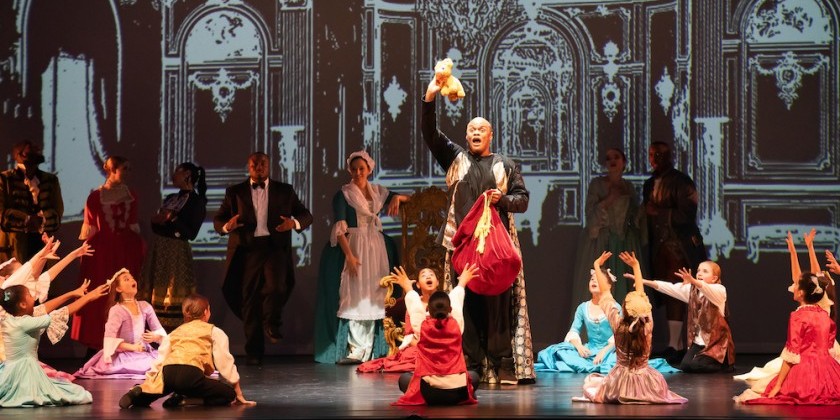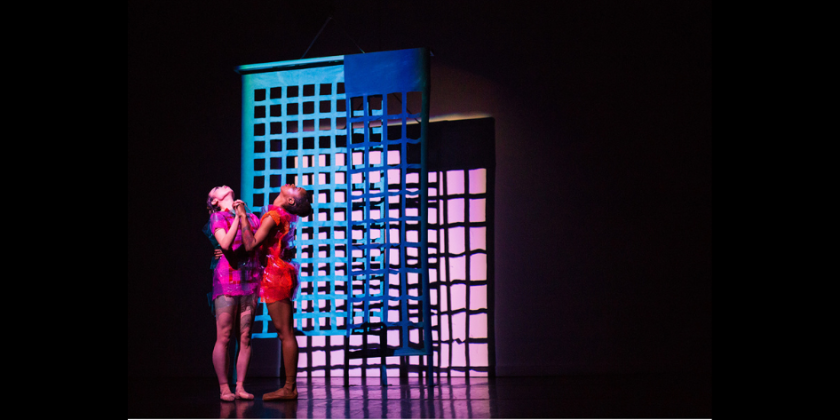THE DANCE ENTHUSIAST ASKS: Lynn Parkerson on the Origins of the Brooklyn Ballet's "Nutcracker"

An Ever-Evolving, Expanding Story
Brooklyn Ballet founder and executive director, Lynn Parkerson, had always dreamed of doing her own version of The Nutcracker. But for years the idea remained in incubation, kindling awaiting a spark. When Brooklyn Ballet was invited to perform at a tree lighting in downtown Brooklyn in 2010, the opportunity provided the inspiration she had been seeking.
In the years that followed, Parkerson has added, refined, and scaled, all in patient service of a vision for a Nutcracker that embodies a uniquely Brooklyn experience – distinctive dance forms and traditions interacting in harmony, and accurate representations of the unique cultural communities that call Brooklyn home.
Theo Boguszewski, for The Dance Enthusiast: I’m excited to chat ! I’ve seen the Brooklyn Ballet Nutcracker and and have written about the socially distanced production you did in 2020. Besides writing here, I work in community development in neighborhoods around Brooklyn, so your concept of including the community resonates with me. I’m told that the Brooklyn Ballet’s production got its start as a duet between a ballerina and a hip-hop dancer on a street corner. Can you share a bit more about this origin?

Lynn Parkerson: We were invited by the Downtown Brooklyn Partnership to do a tree lighting in 2010. Fulton Mall was starting to change, and they were really trying to draw attention to the new businesses here. I had been thinking about a Nutcracker for a long time. Mike "Big Mike" Fields, and I had been collaborating for years, when I told him about this old ballet called The Nutcracker, and the character “The Drosselmeyer,” the sort of magical, strange Uncle, whose part he soon came to choreograph.

Pop-and-lock moves are very robotic, and at the time I was also working with a ballet dancer who created her own version of a mechanical doll choreography. We met at the studio and created a lot of choreographic material. In one rehearsal we created a dance that was the nexus, the beginning, of how I wanted to integrate the street and classical dancers together -- through their characters, their styles, and their techniques, which sometimes mirror each other.
What came next from there? Did you do a full production the next year?
L. Parkerson: Well, I’d always wanted to do a full production, but it was more like finding the beginning, this integration of styles. I wanted to bring the street dancers into different scenes; in the subway, on the street... Brooklyn is full of inspiration. And then there are the iconic Nutcracker scenes, like the "Snowflake Waltz". I wanted to capture my favorite aspects of snow scenes that I’ve seen over the years, and to feel the ecstacy of going from the ballroom of the Victorian house into nature.

When did you present the full production?
L. Parkerson: In 2015, we presented a 50-minute show, our pilot. That sold out immediately for six performances! We added a party scene with the children, with a colleague who came in to teach them Baroque dance. Avram Finkelstein was our the art director. Together we had to figure out a backdrop for this production , since we couldn’t really afford those old-fashioned theater sets. It turns out, you have to pay a lot of money for the technology too.
But it’s more mobile, no? And minimal storage...
L. Parkerson: True! And we are happy with it. We’ve added scene after scene, and Avram has added more imagery, for example, from the Brooklyn Botanical Garden. We keep generating. This is a generative work.

How is the storyline different in 2022?
L. Parkerson: I dispensed with the story when I began this process. It’s bizarre anyway, and there are lots of different ways of interpreting it. The story originally comes from E.T.A Hoffman, but I tell you, that narrative never was what interested me about The Nutcracker. For some people, children really, I think a story would be fantastic. But, right now .. hmm … I’m just not sure what The Nutcracker represents…
So in the future, there could be a new story?
L. Parkerson: Yes. I’m always trying to find new stories. My original idea was for the nutcracker to become a robot, a tech toy, in the 2nd Act. But my feelings about technology have changed so much in the past seven years, I don’t know what I want to say about it. Still, we have new stories every year. Our battle scene is new, and is now one of my favorite sections. For years I avoided it. This year, we took the idea of a hip hop battle and converted it into a battle between ballet and hip hop dancers. The mice are the ballet dancers and the soldiers are the hip hop dancers. It’s very comical.

Can you share a bit about the evolution of some of the divertissements? How did you build the relationships with the varied performers and groups in your Nutcracker ?
L. Parkerson : Well, let's start with the "Spanish" dance. I have a friend who is a dance historian specializing in flamenco. She recommended an African-American flamenco dancer, Aliesha Bryan, who happenst to be born and bred in Brooklyn and the first place winner of Flamenco Certamen 2016. Flamenco has a huge African influence. Aliesha said, “let’s have the hip hop dancers be involved, and then they can also do footwork, and we will get this new sense of a history of flamenco.”
For the Chinese dance, I invited Margaret Yuen, the artistic director of Red Silk Dancers, to create the Chinese variation. She immediately said “I will never dance in The Nutcracker!”
She remembered going as a kid to The Nutcracker and finding the "Chinese/Tea" dance offensive. I had to convince her that this production would not be. And now this divertissment is such wonderful part of our show. It’s an opportunity to explore Chinese dance. Margaret Yuen is on haitus, but Eva Bin Lu has been choreographing the Chinese dance since 2019, and looks forward to bringing her dancers, a big group, every year with a new dance.
And now you've added a Ukranian dance! How did you develop the Ukrainian partnership?
L. Parkerson: To be honest, Russian and Ukraine have similar dance traditions, and the Hopak happens to be a Ukrainian folk dance. It’s a very, very old dance that's genesis in Cossak soldiers return from war. They danced to celebrate and show off. I met the two dancers performing the Hopak for the first time the Saturday before our production, and they were fantastic. Avram had tears in his eyes because he said his father used to take him to see the Moiseyev Ballet and those dances when he was a kid. He was so touched by seeing them in our Nutcracker.

How much of The Brooklyn Ballet's Nutcracker is your choreography?
L. Parkerson: In the program I have a long, long list of collaborating choreographers. The concept is all mine. The "Snow Scene" is 100% mine, and the "Party Scene" except for the "March" itself, which was choreographed by my Baroque colleague. Mike has choreographed all of "Drosselmeyer." The ballet dancers and other dancers have created step material. I created a "Waltz of the Flowers" with a colleague, Claudia Jeschke, who is a dance historian from Germany. I never wanted to do that dance, I never liked it, but she loved it. She brought in these incredible diagrams, based on early drawings from a 19th centurty pattern-book, Tanz-Gruppen, (Dance Groups). It became a beautiful additon. Collaborators bring their own dances, and I choreograph the transitions. I facilitate the transitions between the artists and their stories.











